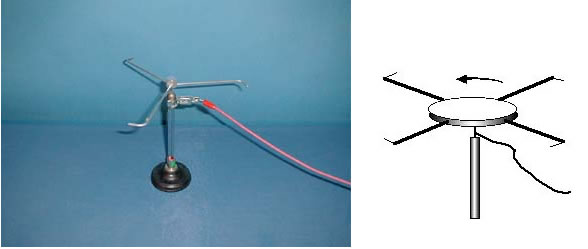Demos: 5A-23 Electric Wind

Two pieces of apparatus illustrate the phenomenon introduced in 5A - 21, namely that the electric field is strongest at sharp points and this is the region where charge is more likely to leak off. First, a sharply-pointed electrode is attached to an electrostatic generator. A candle flame is positioned about a centimeter from the tip of the conductor, along the axis. As the charge builds up on the conductor, an “electric wind” is developed as charges stream from the end of the conductor. It often is possible to extinguish the candle flame with this wind.
The second demonstration makes use of Newton’s Third Law in addition to the “electric wind.” A conducting disk has four conducting arms attached in the manner of a “lawn sprinkler” (see illustration). The disk is pivoted on a sharp point and is electrically connected to an electrostatic generator. As the “electric wind” is propelled from the ends of the arms, action-reaction causes the wheel to spin.
Directions: (1) The candle is attached to a stand and its position adjustable. Place the wick within about a centimeter of the sharp end of the conductor. (Avoid drafts. If necessary, turn off the overhead projector so that the fan will not blow the flame. Light the candle. Making sure that there is a good connection between the conductor and the ESG, turn on the latter. Under the right conditions, the flame will flicker violently and often be blown out completely.
(2) Set the “sprinkler” apparatus on an insulating pad and connect the central shaft to the ESG. Keep the connecting wire suspended to avoid any unnecessary leakage. The wheel should begin to spin within a few seconds and can reach considerable rotational speed.
Suggestions for Presentation: Suggest that although we can’t see the molecules of air in a wind, we can detect its presence by its effect on other objects. For example, moving air can blow out a candle. Then if charges (electrons) are being blown off the end of the conductor, they should create a wind of moving particles.
Applications:
Last Updated: Nov 30, 2023 11:25 AM